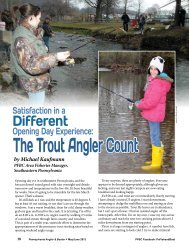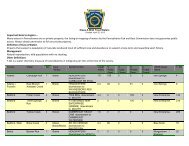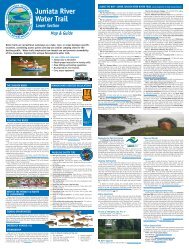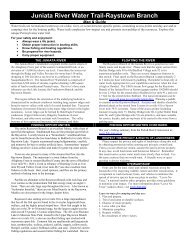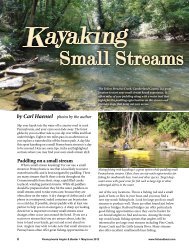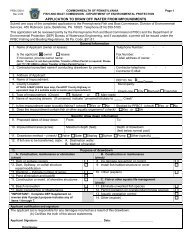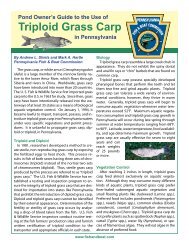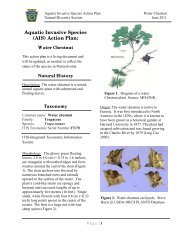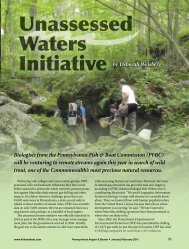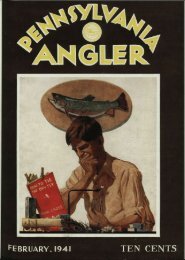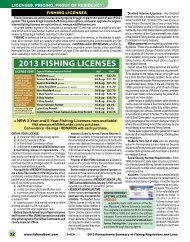m&M: - Pennsylvania Fish and Boat Commission
m&M: - Pennsylvania Fish and Boat Commission
m&M: - Pennsylvania Fish and Boat Commission
You also want an ePaper? Increase the reach of your titles
YUMPU automatically turns print PDFs into web optimized ePapers that Google loves.
I HE fly fishermen has the wonderful opportunity of havln<br />
g his favorite trout stream all to himself on opening day<br />
' •• as a fly fishermen . . . almost everyone else there will<br />
De<br />
using worms. An extremely high percentage of the<br />
tr<br />
°ut's diet is made up from various forms of aquatic life.<br />
Although we see many worms found in the trout stream,<br />
w<br />
orms are not a form of aquatic life <strong>and</strong> when found in the<br />
stream, the worms are undergoing a process commonly<br />
known as drowning. Some worms, previous to entering<br />
tne<br />
water, have been first stabbed to death.<br />
Worm users catch a lot of fish on opening day, but the<br />
an<br />
gler who carefully presents artificial flies, matching the<br />
gout's diet, can catch fish on that same day too. Listed<br />
below are four flies which a group of friends <strong>and</strong> myself<br />
*J av e found particularly successful during the first few<br />
a<br />
ys of <strong>Pennsylvania</strong>'s trout season.<br />
The first is called the Ross Fly. We would have liked<br />
° have been able to name this fly by another name, but on<br />
" e night we "invented" this model, the only one who had<br />
tl, e<br />
material available for the idea was Ross. Contrary to<br />
w<br />
hat I said about artificial flies matching the trout's diet<br />
are<br />
the ones to use, this fly does not. The Ross Fly is<br />
Probably the only fly tied with, I am almost ashamed, the<br />
ea<br />
of its ending up looking like a salmon egg.<br />
This fly is simply natural wool, which has been first<br />
yed a deep pink, applied to a number twelve hook in the<br />
0r<br />
m of dubbing. That's all! Lacking a tail, wings <strong>and</strong><br />
^ckle I am not even sure if one could call this a fly. But,<br />
. he Ross Fly bouncing along a stream bottom during openln<br />
g day is a very deadly thing. It can be tied either with<br />
Wnit<br />
e or black thread <strong>and</strong> often we have found that one<br />
c<br />
°lor would be better than another. This fly does not fall<br />
the hook as easily as that which it is imitating <strong>and</strong> it<br />
Ure<br />
can be a real saver for the fly purist who is at his<br />
ts<br />
end on opening day.<br />
There are dozens of variations of the age old favorite<br />
"p," • the Coachman. This fly is thought to have been in<br />
n<br />
gl<strong>and</strong> as early as 1835, although some believe this pattern<br />
°° es back thirty years before Bosworth's time. Two varia-<br />
,0<br />
ns of this theme which are widely used by <strong>Pennsylvania</strong>'s<br />
n<br />
g'ers are the Leadwing <strong>and</strong> Royal Coachman. The<br />
° a chman is an excellent fly for the first day <strong>and</strong> works<br />
0r<br />
>ders on lake-living brook trout. The other two coach-<br />
. arj s, the Leadwing <strong>and</strong> Royal come in to their own later<br />
U<br />
*e season.<br />
j ne st<strong>and</strong>ard Coachman seems best during opening<br />
. ' in size twelves to as large as number eight. The fly<br />
*"*d with a body of bronze peacock herl <strong>and</strong> a tag of<br />
^°. d flat tinsel. Hackle is red-brown hen's hackle tied wet.<br />
, ln gs are usually cut from matching pairs of mallard<br />
t c * s wings <strong>and</strong> tied wet with the white side out. I like<br />
.j, tie some of my Coachmans with white bucktail wings.<br />
* hucktail holds up better <strong>and</strong> adds a little more action.<br />
i he third fly is one which has been in a great many fly<br />
Xe<br />
s down through the years <strong>and</strong> has been in a lot more<br />
re° ut 's jaws than fly boxes. The Gold-Ribbed Hare's Ear<br />
s Pres ents to fishermen <strong>and</strong> fish alike, many of the different<br />
tr l° leS °^ a( l uat ' c insects found in the trout stream. It is<br />
j i y a hot pattern during the first days of the season <strong>and</strong><br />
° w one elderly veteran of the trout streams who uses<br />
nothing else. Claims if he can't catch them on a Gold-<br />
Ribbed Hare's Ear, the trout just are not hitting. He is<br />
usually right.<br />
The tail of this fly is tied with hackle fibers from either<br />
wood duck, mallard or grizzly. The body is of the same<br />
material as is its name, fur from a hare's ear which is<br />
dubbed in place. The body is then ribbed with fine flat<br />
gold wire. Wings of this fly are cut from the wing feathers<br />
of either a gray duck's or wood duck's wings <strong>and</strong> tied wet.<br />
The hackle is made up from unplucked rabbit's hair. This<br />
fly is usually best early in the season tied in sizes twelve<br />
<strong>and</strong> ten. As the season progresses <strong>and</strong> waters become<br />
lower, clearer; move down to the smaller sizes like fourteens<br />
<strong>and</strong> sixteens <strong>and</strong> keep on taking trout with this same<br />
pattern right through the season. The nice thing about the<br />
Gold-Ribbed Hare's Ear is that the more ragged <strong>and</strong><br />
chewed it gets, the more trout seem to like it.<br />
Last of the four is one of the deadliest of all flies, especially<br />
for big trout. The White Marabou Streamer probably<br />
accounts for the creeling of more monstrous trout<br />
each year, than through the use of any other single fly.<br />
A White Marabou can attract lots of attention when<br />
streams are high <strong>and</strong> muddy as many times they are<br />
during the first few weeks of the season. Marabou fibers<br />
work wonders on trout but to have it work wonders, the<br />
fisherman must get this streamer down where the trout are.<br />
For <strong>Pennsylvania</strong>'s water, a 3X long shanked number<br />
eight hook is a favorite size to use in tying the White<br />
Marabou Streamer. This fly is often tied with a thin lead<br />
wire base to help get it down where the big ones live. The<br />
normal body is added over this lead base <strong>and</strong> it consists of<br />
a flat silver tinsel body with a ribbing of oval tinsel of the<br />
same color. Wing is white marabou fibers <strong>and</strong> should be<br />
tied quite heavy since once the marabou fibers become<br />
wet they pack into a very small size. This fly has a topping<br />
of five str<strong>and</strong>s peacock herl <strong>and</strong> its hackle, tied wet,<br />
is scarlet. Two jungle cock eyes for cheeks complete the<br />
fly. The limpness of marabou fibers makes it a perfect<br />
material for the fly fishermen. Moving through the water<br />
in short pumping jerks, this streamer seems to breath <strong>and</strong><br />
in the h<strong>and</strong>s of expert, the marabou can act more "alive"<br />
than the aquatic life which it imitates.<br />
The four patterns listed here produce fish all through the<br />
year, but these patterns are especially noted for their effectiveness<br />
during the first days of early season. It would be<br />
wise to carry these patterns in both smaller <strong>and</strong> larger sizes<br />
as well as the sizes which have been recommended here.<br />
And also not a bad bet, particularly on opening day, is<br />
to have a couple of each of these flies tied with weighted<br />
bodies. No matter how effective a fly may be, it can not<br />
catch fish unless it is operated where the fish are <strong>and</strong><br />
second, acts in the manner as its natural counterpart.<br />
Try these four patterns on opening day. They can suddenly<br />
change the peace <strong>and</strong> solitude you hope to find on<br />
the stream into a real battle April 17, 1965. An amazing<br />
amount of <strong>Pennsylvania</strong> trout have read this article <strong>and</strong><br />
will be acting accordingly.<br />
By the way, if any readers have found a way to tie<br />
a fly which imitates a worm, I would appreciate hearing<br />
about it.<br />
APR «~1965 13



